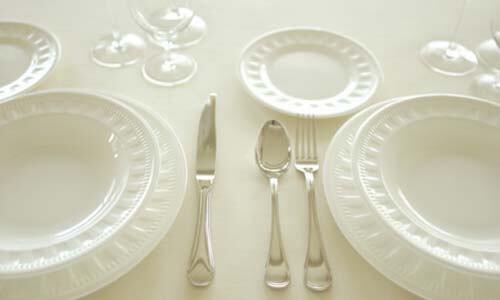Coffee Makers
Coffee is made by decoction or infusion.
decocted coffee
Decocted coffee is "cooked," or boiled in an open pan; this is the oldest way to make coffee. Boiled water activates the tannic acid, promotes brew with a bitter taste, and produces a cloudy cup of coffee.
ibrik
Turkish coffee is made in an ibrik or a cezve (pronounced "jezwe"), a small, long-handled, conical-shaped pot made of copper or brass lined with tin.
- The pan is filled half-full with cold water; this allows space for a thin brown loam to develop as the coffee is cooked it developes a froth the Arabs call kaimaki, or "the face of coffee,"
- The grounds are suspended by swishing the brew about before it is poured into the cup. The long handle and narrow upper perimeter of the pan makes this possible.
- Turkish coffee is heated until it boils and removed from the burner immediately, because the brief boil robs coffee of flavor.
- As cold water is heavier than hot water, to halt the boil a bit of cold water is added to the pan.
- The pan is returned to the heat a second time, the water is brought to a boil, removed, and cold water is added again.
- The process is repeated, but never more than three times, because moisture and air rob coffee of oil and promote a bitter taste.
- After the final boil, cold water is added to settle the grounds, and the kaimaki, or foam, is divided equally among the guests.
- Approximately a tablespoon is spooned into small stemmed cups or demitasse cups.
If Turkish coffee lacks foam the host loses face.
infused coffee
Infusion produces flavorful coffee with clarity and, depending on the coffee maker, leaves little sediment in the cup. There are five methods for making infused coffee: steeped, percolated, vacuum method, filtered, and espresso.
steeped coffee
Steeped coffee, from the Old Norse word steypa, meaning "to pour out liquids," was developed from decocted coffee in the eighteenth century by the French. It is the second oldest way to brew coffee. Steeped coffee is made in a plunger pot or an open saucepan.
A plunger pot, such as a Bodum, is used to steep coffee. The grounds are placed in the bottom, the water is added, and the brew is steeped for the desired time. Just before serving, the strainer is pressed down to the bottom of the pot; this separates the grounds from the brew and produces coffee with a rich, full-bodied taste, one that leaves little sediment in the cup.
Coffee steeped in an open pan is prepared with cold, fresh water brought to a simmer. The water is removed from the heat and poured onto the grounds. To promote even wetness, the grounds are stirred for approximately 30 seconds. The brew is covered and allowed to steep. Just before serving, a little cold water is added to the pan to settle the grounds to the bottom. Then the brew is poured through a strainer into a cup or a mug.
But coffee steeped in an open pan leaves sediment that clouds the brew. Additives such as egg whites, fish skins, or eggshells are put in the pan as clarifiers. The English prefer egg whites because the albumin absorbs the cloudiness as it coagulates and is easy to skim off. However, the Scandinavians prefer fish skins, although they tend to flavor the brew. And cowboys cooking eggs over an open camp fire use the crushed shell of one egg as a clarifier.
percolator coffee
Percolator coffee, from the Latin percolare, "to strain through," is the third oldest way to infuse coffee. The percolator was invented in 1800 by Jean-Baptiste de Belloy, archbishop of Paris, and improved upon in 1825 by Benjamin Thompson of Woburn, Massachusetts, an eccentric American who called himself Count von Rumford.
In the percolator, the coffee grinds are placed in the pot's metal basket and the cold water is added to the pot. The coffee maker is covered and the steam generated by the heated water creates pressure that forces the water up through the strainer and over the grounds many times. The percolator recycles the water, exposes the grounds to air, reduces the aroma, increases the tannin, and promotes brew with a bitter taste. This coffee maker is therefore not recommended by coffee connoisseurs. In the interests of flavor, electric percolators turn off automatically at the end of the brewing cycle.
vacuum coffee makers
Vacuum coffee makers are adapted from an invention made in 1870 by Robert Napier. a Scottish marine engineer. The coffee maker is known by such brand names as Silex and Cona. Vacuum coffee makers produce clear, sediment-free coffee with a pleasant taste and a tantalizing aroma.
The vacuum coffee maker is made with an upper and lower globe connected by a tube that siphons water from the lower to the upper container. Although a spirit lamp rests under the lower bowl, to speed up the brewing time, the water is often heated in a kettle before it is added to the globe. As the water in the lower globe boils. it builds up steam that creates pressure and is vacuumed into the upper balloon, where it mixes with the grounds. For even infusion the grounds are stirred. After the coffee has steeped, the spirit lamp is extinguished and the coffee maker is removed from the heat. The air in the lower globe contracts and creates a vacuum that sucks the brew from the upper globe into the lower balloon, in a trickle.
filtered coffee
Filtered coffee, also known as drip coffee, is the newest method of coffee infusion and the preferred method of coffee afficianados. The coffee filter was invented by Melitta Bentz, a German housewife who in 1908 filtered her husband's cup of coffee through a linen towel.
The drip coffee maker features an upper and lower container, and the grounds are filtered through a strainer made with fine pores. Hot water of approximately 195 to 205°F (91 to 96°C) is poured over the grounds once. The grounds are stirred, and the brew flows into the pot below producing a mellow taste and little sediment. The filter is removed. To balance the flavor, the pot is swirled before the brew is poured.
The drip coffee maker is made in electric and non-electric models. Electric models, such as Melitta, Krups, and Mr. Coffee, turn off automatically. Non-electric models take longer to brew.
espresso
Espresso is a fast-brewing machine that forces steam through a funnel into an upper container filled with dark-roasted grounds. This method produces a full-bodied brew with an almost syrupy consistency and a strong taste.



